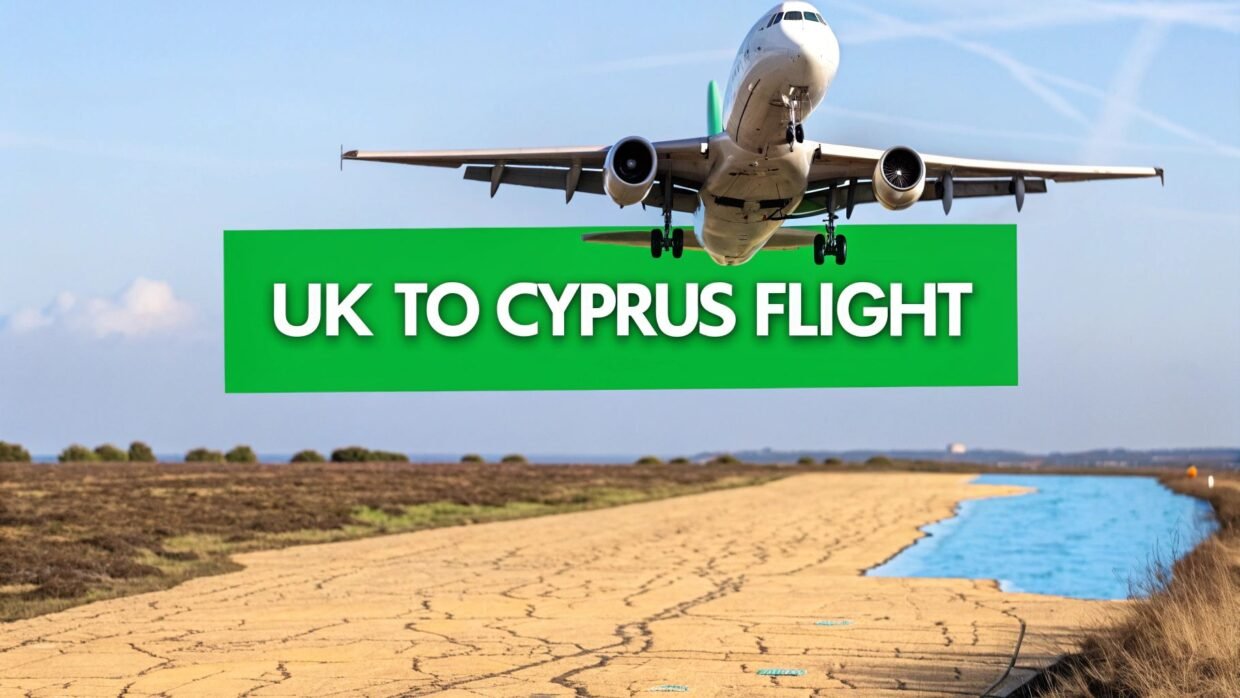So, you're planning a trip to sunny Cyprus? Fantastic choice. One of the first things you'll want to know is just how long it takes to get there. The short answer is that a direct flight from the UK will have you touching down in about 4 hours and 30 minutes to 5 hours and 30 minutes.
Think of it this way: it's just enough time to settle in, watch a couple of good films, and get excited for the Mediterranean sunshine awaiting you.
Your Quick Guide to UK to Cyprus Flight Times
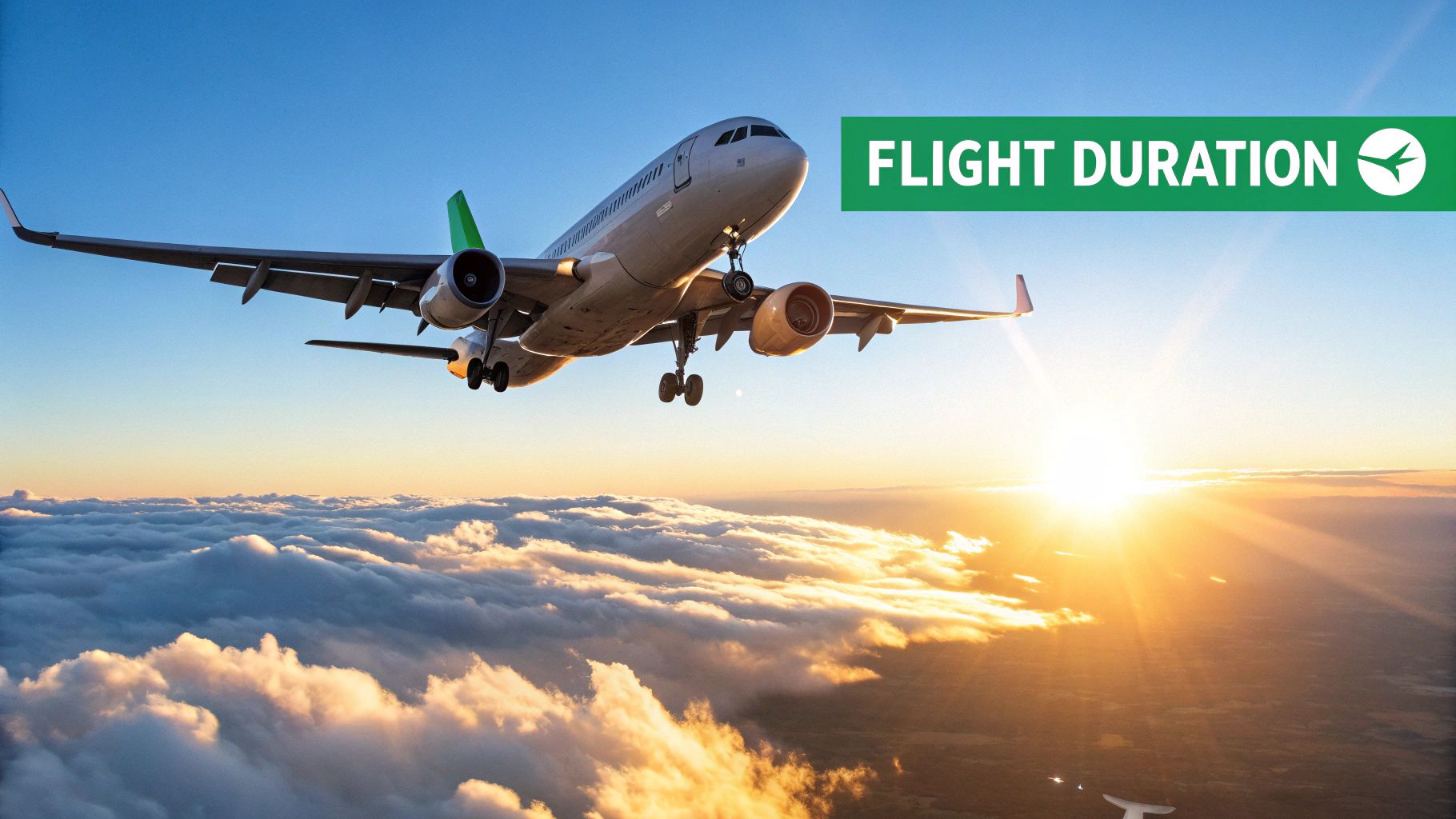
While that 4.5 to 5.5-hour window is a solid rule of thumb, your actual time in the air can vary slightly. A few things come into play:
- Which UK airport you fly from.
- Whether you land in Larnaca (LCA) or Paphos (PFO).
- The specific airline and route.
- Even the wind conditions on the day!
On average, most non-stop flights from the UK to Cyprus clock in at around 4 hours 50 minutes. You’ll find plenty of options from major hubs like London Heathrow, Gatwick, Manchester, and Birmingham, with the Gatwick to Larnaca route being a particularly popular one for holidaymakers.
To give you a clearer idea for planning, here’s a table showing the typical direct flight times from the UK's biggest airports.
Estimated Direct Flight Times from Major UK Airports to Cyprus
This table provides a handy overview of what to expect for direct flights from the UK's main airports to Cyprus's two international hubs, Larnaca (LCA) and Paphos (PFO).
| Departure Airport (UK) | Arrival Airport (Cyprus) | Average Flight Time |
|---|---|---|
| London Gatwick (LGW) | Larnaca (LCA) | 4 hours 35 minutes |
| London Heathrow (LHR) | Larnaca (LCA) | 4 hours 45 minutes |
| Manchester (MAN) | Paphos (PFO) | 4 hours 55 minutes |
| Birmingham (BHX) | Paphos (PFO) | 4 hours 50 minutes |
| Bristol (BRS) | Larnaca (LCA) | 4 hours 40 minutes |
As you can see, there isn't a huge difference between them, but it helps to know what to expect for your specific journey. For a deeper dive into all the variables, check out our complete guide on UK to Cyprus flight durations.
Mapping Your Direct Flight from the UK
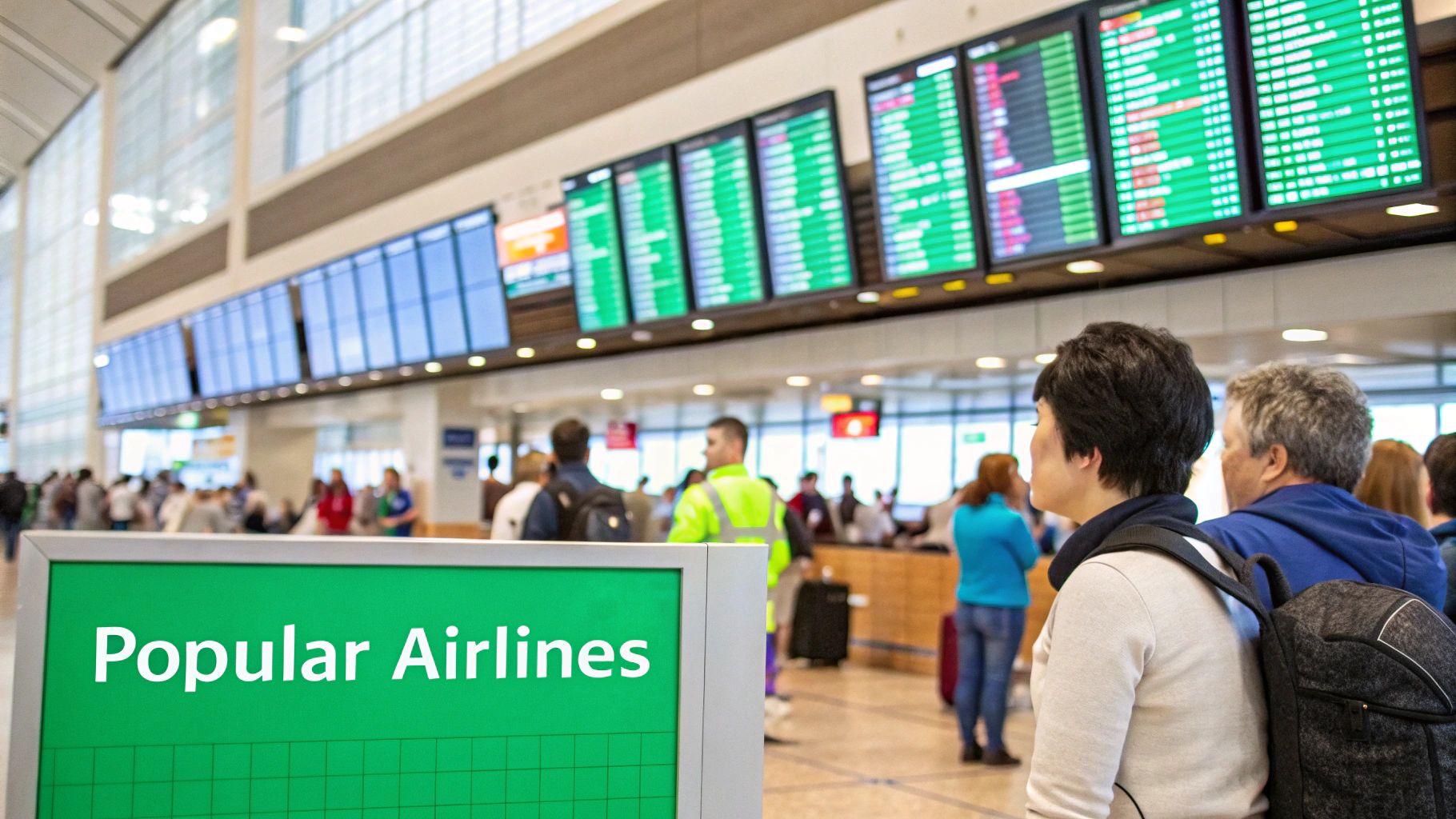
While it’s useful to know the average flight time, figuring out how long is the flight to Cyprus from UK airports beyond London is what really makes a difference. Let’s be honest, starting your holiday with a stressful, hours-long drive down the M1 or M25 isn't ideal.
Thankfully, you don't have to. Cyprus is incredibly well-connected, with direct flights available from cities all over the UK. Major airports like Manchester, Birmingham, Bristol, and even Glasgow offer non-stop services. This turns what could be a long, drawn-out travel day into a simple, straightforward trip, meaning you can spend more time thinking about which beach you’ll hit first.
Key Regional Departure Hubs
Many people don't realise just how many options they have right on their doorstep. Airlines have caught on to the fact that the entire nation is after a bit of Cypriot sunshine, not just those living in the South East.
Here’s a quick look at some of the most popular departure points:
- From the North: Manchester Airport (MAN) is a massive hub offering frequent flights to both Larnaca and Paphos. You’ll usually have a good choice of airlines here.
- From the Midlands: Birmingham Airport (BHX) offers fantastic connectivity, making it a go-to for a huge part of the country.
- From the South West: Bristol Airport (BRS) has excellent routes, saving anyone in the South West and Wales a long trek over to London.
- From Scotland: You can fly direct from Glasgow (GLA), connecting Scotland straight to the sunny Med without any hassle.
Remember that choosing your departure airport is also about where you want to land in Cyprus. Some airlines and routes are specific to either Larnaca (LCA) on the east coast or Paphos (PFO) on the west.
For instance, you'll often find that holiday specialists like Jet2 and TUI have a strong presence from northern airports, while British Airways focuses its operations mainly from London. A quick check of who flies where is the secret to a seamless journey from your front door to the hotel pool.
The Hidden Factors That Shape Your Flight Time
You’ve probably noticed it yourself. Your ticket says the flight to Cyprus is 4 hours and 45 minutes, but you touch down 20 minutes early. Or maybe you arrive 15 minutes later than scheduled. This isn't just a random fluke; it's a fascinating dance between physics, technology, and nature that dictates your real-time journey.
Think of your aeroplane like a swimmer in a powerful river. The direction of the sky's "current" can either give you a helpful push or hold you back. In aviation, this current is the jet stream – a high-altitude, fast-flowing ribbon of wind that snakes its way around the globe.
Flying eastwards towards Cyprus, your plane often catches a ride on this jet stream, getting a nice tailwind. It's like swimming with the current, and it can easily shave precious minutes off your flight. On the way back to the UK, however, the plane is flying against it, battling a headwind that can add a little extra time to your journey.
The Route Less Travelled
It's not just about the wind, though. The path your flight takes isn't a straight line on a map. Air Traffic Control (ATC) acts like a choreographer for the skies, directing planes along specific airways to keep everything safe and prevent aerial traffic jams.
Sometimes, your pilot might be instructed to take a slightly longer route to navigate around a storm or avoid a particularly busy patch of airspace over another country. These minor detours are all part of ensuring a smooth and safe flight, but they can tack on a few extra minutes to the total time.
The aircraft model can also make a subtle difference. For a medium-haul trip like this, the time difference between a Boeing 737 and an Airbus A320 is usually negligible, but their optimal cruising speeds and how quickly they can climb to altitude do vary slightly.
A flight's advertised duration is always an expertly calculated estimate. It's based on average wind conditions and the most common routes. But the unique, real-time conditions on your specific day of travel are what create those small, often surprising, variations in your arrival time.
While these factors cause small changes, the biggest impact on your total travel time is whether you have a layover. This image really puts it into perspective.
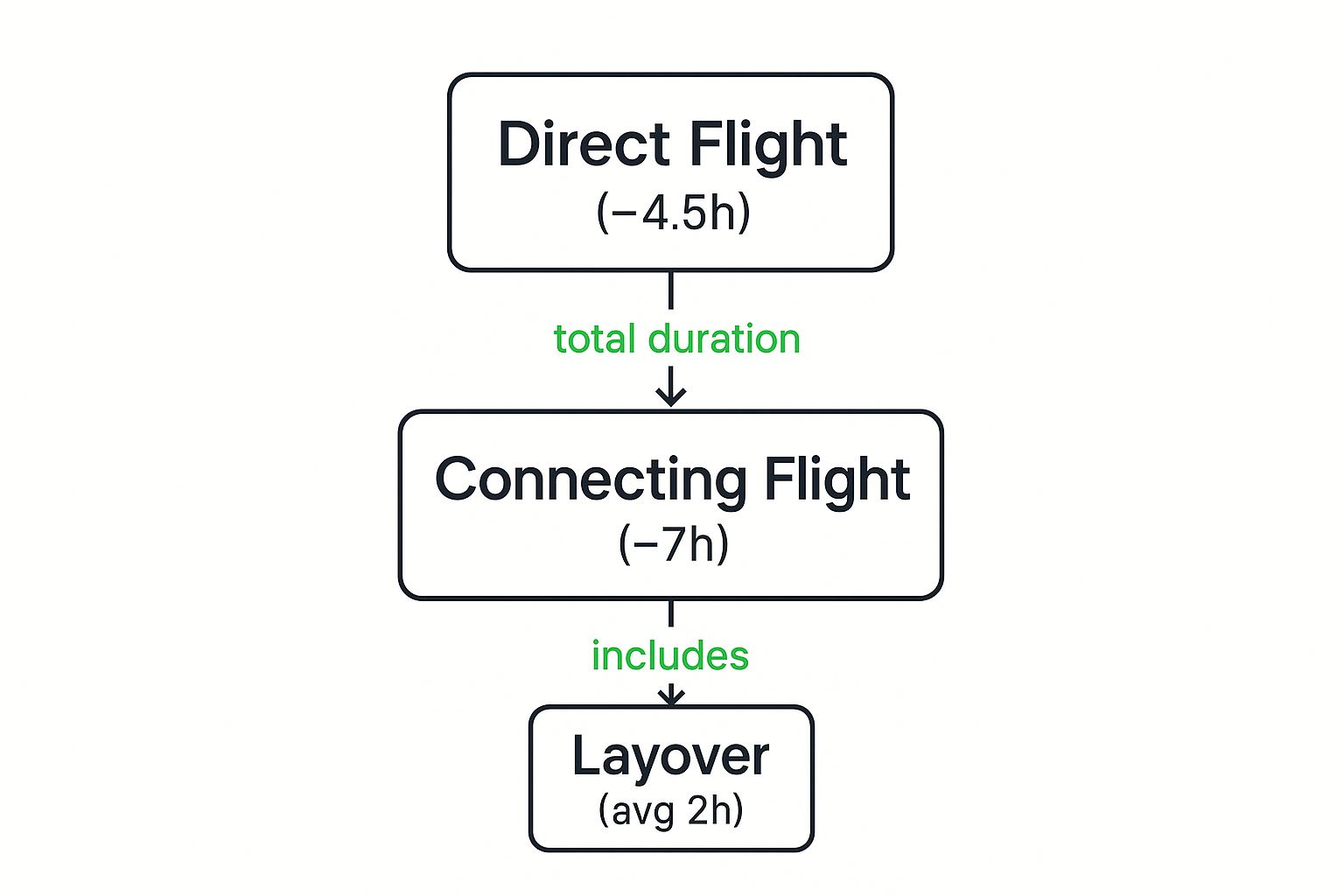
As you can see, a connecting flight, once you factor in the layover, can easily double the total time it takes to get to your destination. It's a trade-off between price and convenience that's well worth considering.
Connecting Flights Can Mean Cheaper Fares
While a direct flight gets you to the sunshine the fastest, a connecting flight often makes a very strong case for your wallet. The real question is, are the savings worth the extra time spent travelling? Getting this balance right is the secret to booking the perfect trip to Cyprus.
Choosing an indirect route completely changes the shape of your travel day. What was a simple five-hour flight can easily become a ten-hour journey, or even longer. Think about it: a layover in a major European hub like Athens, Frankfurt, or Vienna doesn't just add the time you're on the ground. You also have to factor in the time it takes to get off the first plane and board the next one.
Weighing Cost Against Convenience
Ultimately, the choice boils down to what you value most for this particular holiday: your time or your money. The difference in price can be significant, sometimes knocking hundreds of pounds off the total, which is especially tempting if you're booking late or travelling in the school holidays. But that saving comes directly out of your precious holiday time.
Before you jump on a cheap indirect flight, have a think about these points:
- Total Journey Time: Don't just look at the layover duration. A seemingly "short" two-hour stop can stretch your total travel day to between 8 and 10 hours once you add everything up.
- The Layover Airport: A slick, modern airport like Frankfurt offers a vastly different experience to a smaller, more chaotic one. Check where you'll be stopping.
- The Stress Factor: Let's be honest, connecting flights add a layer of worry. A delay on your first flight could put your connection at risk, starting a stressful domino effect.
The question isn't just about how long the flight to Cyprus from the UK is. It’s about how long your entire door-to-door journey takes. Saving £100 might not feel so great if you arrive at your hotel exhausted and frazzled.
In the end, it’s about making a realistic choice that suits you. If you’re on a tight budget and don't mind embracing a longer travel day as part of the adventure, an indirect flight is a fantastic option. But for those who want to feel like their holiday has started the moment they shut their front door, the premium for a direct flight is often money well spent.
For more expert tips on finding the best route for your trip, take a look at our detailed guide on how to fly to Cyprus from the UK.
Choosing Your Gateway: Larnaca vs Paphos
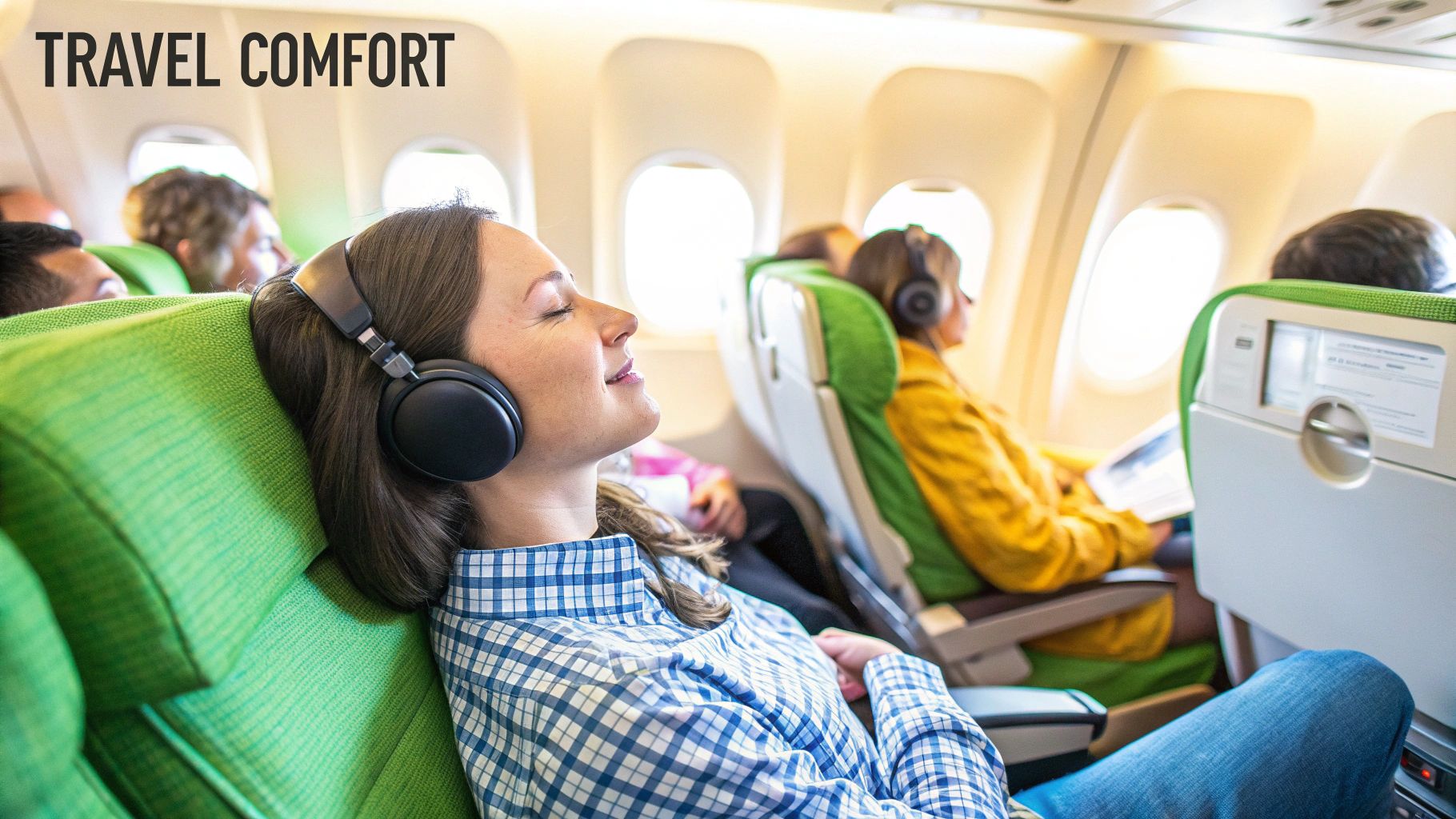
When you're booking a flight to Cyprus, you'll likely face a choice between its two main international airports: Larnaca (LCA) and Paphos (PFO). Where you land isn't just about logistics; it's the first decision that shapes the kind of holiday you're about to have. Each airport opens the door to a very different side of the island.
Think of Larnaca International Airport (LCA) as the island's bustling main hub. Located on the southeastern coast, it's the larger and busier of the two. Flying into Larnaca is the perfect choice if you're headed for the vibrant, high-energy resorts famed for their nightlife and sprawling golden beaches.
For anyone planning a trip to Ayia Napa or Protaras, landing at Larnaca is a no-brainer. These iconic spots are just a short drive away, which means less time on a transfer bus and more time by the pool. You’ll find that most major airlines, from full-service carriers to budget-friendly ones, fly into Larnaca, giving you a wider choice of flights.
Paphos: The Relaxed Western Welcome
Over on the other side of the island, Paphos International Airport (PFO) provides a much more laid-back welcome. It's the ideal gateway for anyone wanting to explore the historic charm and scenic beauty of western Cyprus.
If your itinerary is filled with ancient ruins, quaint villages, and dramatic coastlines, Paphos puts you right in the heart of the action. It's the natural choice for reaching popular destinations like Coral Bay or even the city of Limassol. Paphos itself is a UNESCO World Heritage site, packed with archaeological wonders, making it a fantastic base. Many UK low-cost carriers, especially from regional airports, tend to fly here, often resulting in some fantastic deals.
Your airport choice essentially sets the tone for your holiday. For a trip centred on lively beach clubs and buzzing entertainment, Larnaca is your best bet. If you're after a getaway rich in culture, history, and tranquil coastal drives, Paphos is the clear winner.
No matter which airport you choose, remember you'll be arriving in a member country of the European Union. If you’re curious about what that means for your travels, you can find out everything you need to know about if Cyprus is in the EU in our handy guide.
Right, let's tackle some of the common questions that pop up when you're planning a trip from the UK to Cyprus. Getting these details sorted will have you feeling ready for your holiday in no time.
When Is the Best Time to Fly?
If you're dreaming of a classic sun-and-sand holiday, the peak season from April to October offers the most flights and the hottest weather. Just be prepared for higher prices to match the demand.
For a great sweet spot, have a look at the "shoulder" months. Flying in March, April, or even November often means you get that lovely Cypriot weather with fewer crowds and better deals on flights. Winter is your best bet for the cheapest fares, but you'll be trading sunshine for cooler, sometimes wetter, days.
Which Airlines Fly Directly?
You've got a good mix of options here. Big carriers like British Airways tend to fly from the major London airports.
However, most of the direct routes, particularly from regional airports across the UK, are handled by popular holiday airlines. You'll see familiar names like Jet2, TUI, easyJet, and Ryanair dominating these schedules. Keep in mind that flight availability can change with the seasons, so it's always worth checking a comparison site for your specific dates.
Cyprus has become a massively popular destination for us Brits. Back in the mid-90s, only about 200,000 of us flew there each year. Fast forward to the late 2010s, and that number had more than doubled to around 475,000 annually, with summer being the busiest time. You can dig into more of this data in the official UK Civil Aviation Authority report if you're curious about travel trends.
What Is the Time Difference?
Yes, Cyprus is two hours ahead of the UK. The country runs on Eastern European Time (GMT+2). Don't forget to wind your watch forward when you land so you can dive straight into holiday mode without missing a beat









